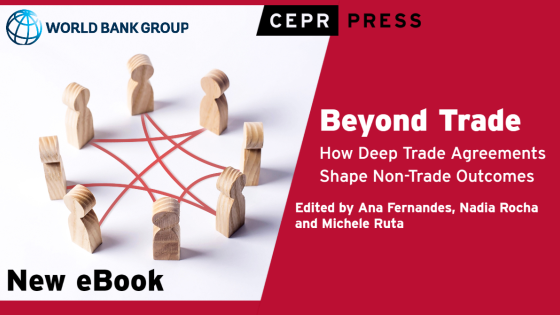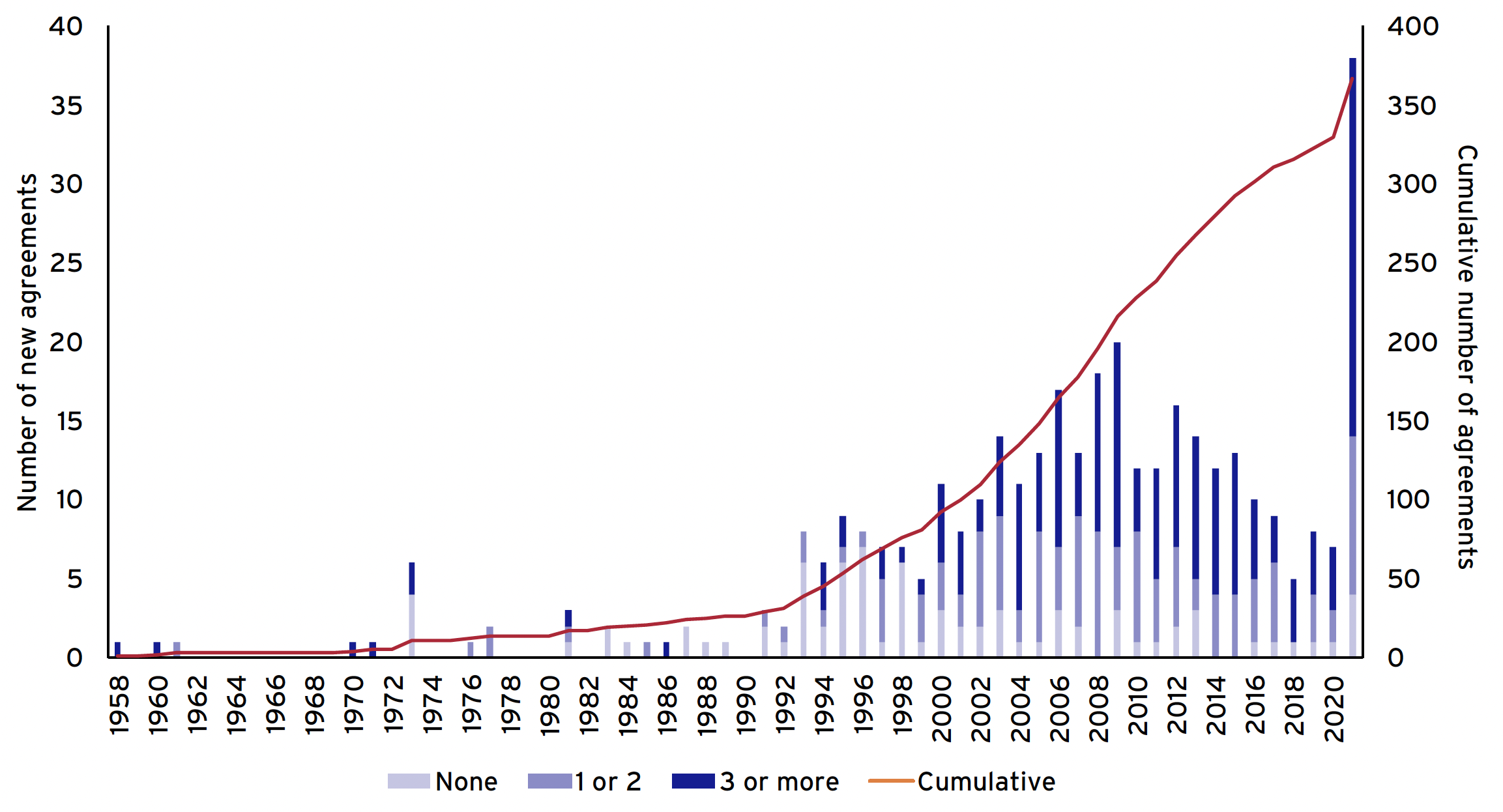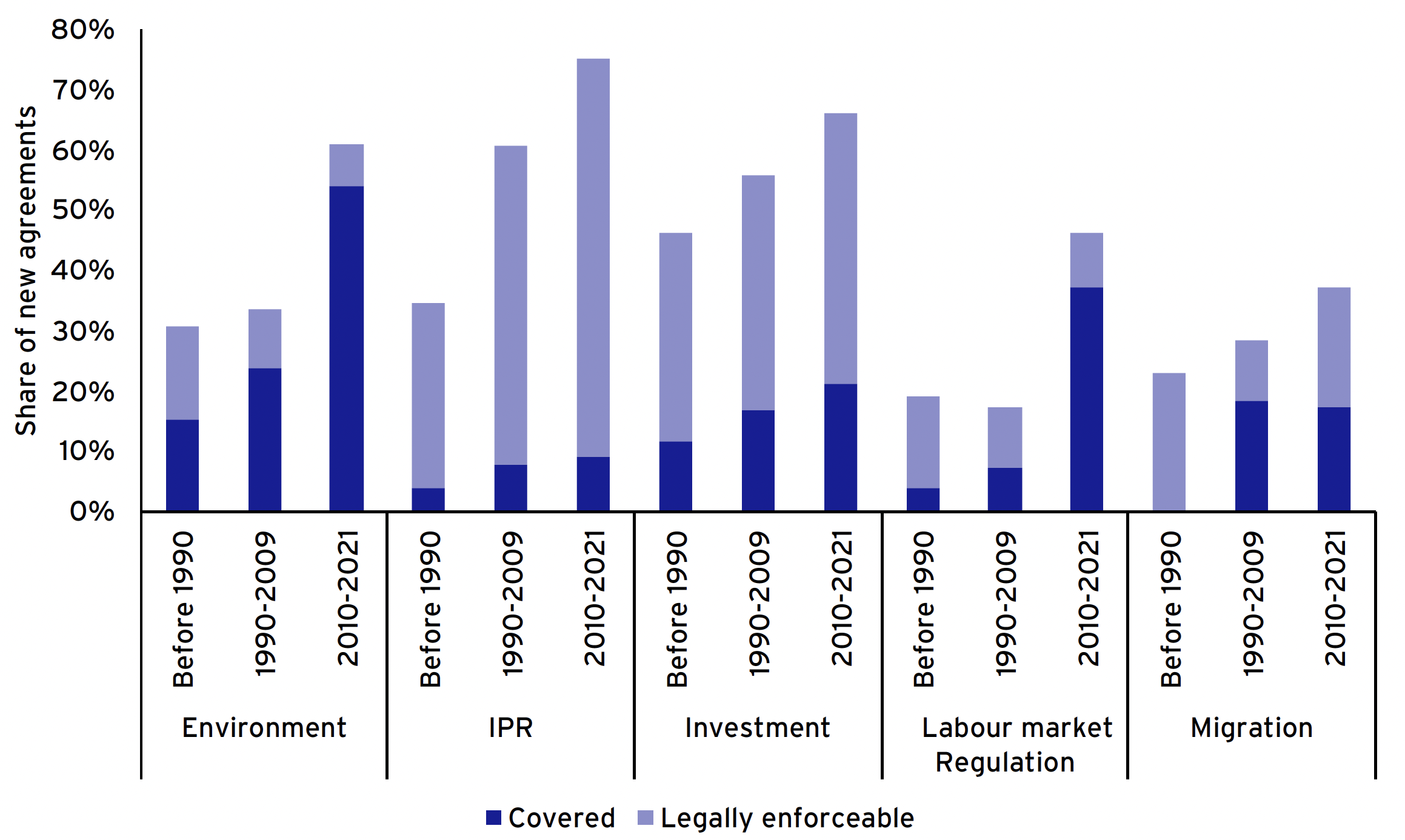Preferential trade agreements (PTAs) have been a key policy tool in shaping trade relations in the past 30 years. Their number has increased, from less than 50 in 1990 to 350 today. Their scope has also widened over time, with many PTAs becoming ‘deep’ as they cover more policy areas and require more stringent commitments (Mattoo et al. 2020). Since the classic work by Baier and Bergstrand (2007), a vast body of empirical literature has analysed the impact of PTAs on trade with members and non-members (for reviews, see Freund and Ornelas 2010 and Limao 2016). More recent work has focused on the distinctive role of deep trade agreements in promoting trade and on how these effects result from specific provisions in PTAs (for a recent collection of studies, see Fernandes et al. 2021).
A new CEPR-World Bank eBook (Fernandes et al. 2023) brings together new research on the impact of trade agreements on a broad range of non-trade outcomes. These include diverse areas such as foreign direct investment (FDI), innovation, policy stability, labour standards, environmental quality, and political rights. Of course, the increase in trade brought about by trade agreements has an impact per se – positive or negative – on non-trade outcomes. For instance, having access to larger markets can help promote a surge in FDI in member countries. More open trade, in the absence of appropriate domestic policies, can lead to faster depletion of natural resources such as forests. But do non-trade policy areas in PTAs directly influence non-trade outcomes?
The chapters in this eBook build on the detailed information from the World Bank’s Deep Trade Agreements Database, introduced by Mattoo et al. (2020), to analyse if and how non-trade disciplines in PTAs affect non-trade outcomes. Indeed, the inclusion of provisions that deal with non-trade objectives is increasingly a salient characteristic of PTAs, especially those signed by advanced economies such as the EU and the US with developing countries. Underlying this transformation in the content of trade agreements are multiple reasons, ranging from the changing nature of trade with the growing importance of global value chains to the changing politics of trade, with issues like the protection of labour rights and the environment increasingly seen as central in the ratification process of PTAs. Whatever the reasons for non-trade disciplines in PTAs, there is little understanding about their effects – i.e. whether these non-trade provisions actually achieve the intended goals.
The research in this eBook helps fill this important gap. In this column, we present the highlights of this analysis.
The evolution of non-trade disciplines in PTAs
Preferential trade agreements increasingly include different types of non-trade provisions. First, PTAs pursue economic integration, that is, free (or freer) movement of goods, services, capital, ideas, and people. As such, PTAs cover policy areas such as investment, intellectual property rights protection, and visas and asylum that aim at regulating FDI, technology diffusion, and migration flows. Second, policy areas such as labour and environmental regulation aim at improving social welfare or protecting rights that could be impacted by market integration, by regulating the behaviour of exporters. For illustrative purposes, Figure 1 shows how the coverage of these five policy areas in PTAs has evolved – pointing to a large increase over time.
Figure 1 Evolution of non-trade disciplines over time
Source: Authors’ calculations based on Hofmann et al. (2017).
Note: the figure shows the number of new PTAs that include different numbers of provisions (none, 1-2, 3 or more) in the 5 policy areas: environment, intellectual property rights, investment, labour market regulation, and migration.
Figure 2 illustrates the wide heterogeneity in the coverage of non-trade policy areas in PTAs and their enforceability. Disciplines on intellectual property rights, investment, and the environment tend to be more frequent than disciplines regulating labour market conditions and migration. For example, in the period 2010–2021, 66% of PTAs included investment disciplines, compared to 37% covering migration. Interestingly, the most dynamic areas are environment and labour market regulation: PTAs including disciplines in these areas more than doubled between the period before the 1990s and the period 2010–2021. More than 60% of new agreements that entered into force in the latter period included these disciplines. Finally, there is also heterogeneity in terms of the legal enforceability
of the policy areas regulating non-trade outcomes. While 66% and 45% of new agreements covering intellectual property rights and investment, respectively, are also enforceable, fewer than 10% of agreements covering environment and labour market regulations are legally enforceable.
Figure 2 Evolution over time in coverage and legal enforceability of non-trade disciplines in PTAs
Source: Authors’ calculations based on Hofmann et al. (2017).
We turn next to the effects on non-trade outcomes of non-trade disciplines in PTAs. The analysis leads to four main findings.
Intended and unintended consequences
Non-trade provisions in trade agreements promote integration beyond trade. Through decreases in trade and migration costs, PTAs promote movement of capital and people across members, along with trade flows. Indeed, sizeable benefits for FDI flows from trade agreements arise only when investment provisions are included. At a more granular level, PTAs – namely, those including investment, movement of capital, intellectual property rights, and competition policy provisions – foster cross-border firm ownership linkages (especially vertical) across countries. And the inclusion of visa provisions in PTAs stimulates bilateral migration stocks, especially of low-skilled immigrants. Intellectual property rights (IPR) provisions in PTAs tend to improve and harmonise IPR standards, reduce patent application costs, and strengthen protection for patent holders, thus encouraging greater cross-border patenting activity among members.
Non-trade provisions in PTAs in areas that aim to enhance welfare by regulating the behaviour of exporters can also be effective. In particular, environmental disciplines are found to help shape environmental outcomes. The inclusion of binding environmental provisions in PTAs limits their nefarious impact on deforestation. Signing a PTA generally supports the aims of international environment agreements like the Montreal Protocol, which limits trade in ozone-depleting substances (ODS) goods with non-member countries, by increasing the likelihood of member countries ratifying its amendments. But the effects are shown to be much stronger if the trade agreement includes ODS-related provisions. The rationale for such impacts is the introduction of enforcement measures for non-compliance in PTAs with ODS-related provisions.
But non-trade provisions in PTAs in areas of labour and civil or political rights are not always effective and can have unintended consequences. Non-trade provisions in PTAs in areas of labour and civil or political rights do not significantly improve indicators on labour rights, workers’ protection, democracy, and political rights in member countries.
Binding labour provisions in EU PTAs actually result in a deterioration of worker protection. A study of the impact of child labour standards in PTAs similarly finds that simple bans have a perverse effect on child labour outcomes. PTAs without child labour provisions reduce child employment and increase child school enrolment but, paradoxically, trade agreements with child labour provisions do the opposite. The rationale for this result is that child labour bans can lead to a decline in child wages and a decline in the income of poorer households, requiring them to actually increase the supply of child labour.
Design matters for non-trade outcomes
The design of non-trade provisions matters for non-trade outcomes. First, in some cases there is a minimum set, or core, of disciplines that are needed for the realisation of underlying non-trade policy objectives. For instance, not all PTAs with IPR provisions encourage more technology transfer through patent flows among members. PTAs that involve only some legally enforceable IPR provisions, and thus ensure a weaker protection to patent applicants, do not stimulate further bilateral patenting among members. The PTAs that are most effective in promoting patent flows are those that include a ‘strong’ protection that goes beyond the standards established by the WTO Agreement on Trade-Related Aspects of Intellectual Property Rights (TRIPS).
Second, and related to the above point, there are trade-offs in the complexity of non-trade disciplines. Overly complex provisions can have adverse consequences. For example, an increase in investment provisions related to transparency and regulations is shown to actually decrease FDI given the large compliance costs they impose. But in other cases, it is the simplicity of the provisions that can be problematic. The child labour bans discussed above are a case in point. The rule is simple, direct, and easily understood by relevant constituents in advanced economies. But it does not account for the incentives that are faced by the poor households in developing countries that are affected by the measure. Rather than simple bans, labour clauses in PTAs should encourage active education policies that favour the poor, such as direct payments to households for school attendance.
A third element is the legal enforceability of non-trade disciplines. A key element of the effects of PTAs is that they change current and expected policies. The reduction in policy uncertainty brought about by legally binding disciplines is critical to understand the impact of PTAs on trade and non-trade outcomes. For example, whether environmental provisions are subject to formal dispute settlement mechanisms or non-enforceable matters for environmental outcomes. PTAs with non-binding environmental provisions lead to a significant deterioration in several indicators of environmental quality: CO2 emissions, ozone exposure, protected biological diversity, and sustainable nitrogen management in agricultural production. These adverse effects point to the pressure put on the environment by the increase in production and trade associated with the signing of a PTA and suggest that non-binding environmental provisions in PTAs fail to ameliorate those pressures.
Heterogenous effects
The effects of non-trade provisions in PTAs can be heterogeneous, depending on the countries involved and the power relations among members. PTAs affect FDI very asymmetrically across countries, with China and the US benefitting most in terms of their outward FDI while East Asian and Latin American countries with a large number of PTAs (such as Chile, Peru, Singapore and Thailand) benefit most in terms of inward FDI. When origin and destination countries belong to different income groups, PTAs with visa provisions are stronger in fostering bilateral migration, but weaker effects are observed when destination countries have a large share of votes for parties at the extreme right of the political spectrum. PTAs including strongly enforceable IPR provisions encourage patent applications from non-members to developing country members, suggesting the stronger IPR standards in the PTAs make these countries more attractive locations to protect and deploy new products. In all these cases, it appears that PTA disciplines can help fill a gap in national legislations – if the discipline is properly designed and the right political economy conditions are present.
The role of complementarities
The effects of PTAs with non-trade provisions on non-trade outcomes depend on the overall content of the PTA as well as on other policies in place in member countries. There are complementarities between investment provisions and provisions on labour markets, exports, taxes, public procurement, and state-owned enterprises in fostering significantly FDI between PTA members. There is also a complementarity between IPR provisions and provisions on investment in PTAs in stimulating cross-border patenting.
Complementary policy instruments may play a role in making PTAs with non-binding non-trade provisions more effective in improving non-trade outcomes. One such instrument, official development assistance, may influence whether non-trade provisions are implemented. High-income PTA members – the major proponents of non-trade provisions – allocate more aid to countries that agree to soft (non-binding) provisions in the areas of environment and human and civil rights. Non-binding non-trade provisions may thus act as focal points for cooperation among countries on an issue area.
Conclusions
Trade agreements increasingly include disciplines aimed at achieving non-trade objectives: promoting FDI, technology transfers, and workers’ movement, but also improving labour conditions and environmental quality and achieving other broader social goals. Do these provisions actually achieve their intended goals? The research presented in this eBook provides a first empirical assessment of the effectiveness of non-trade disciplines in PTAs. The evidence points to some successes, such as in the area of FDI, technology transfers, and the environment, but also to the limits of regulating non-trade policy areas in trade agreements, as in the case of the perverse effects of child labour bans on children’s employment and school enrollment. As governments’ trade policy agendas in the post-Covid, post-Ukraine war world expand to consider new and wider non-trade objectives, from supply chain resilience to national security, we hope that the early work presented in this eBook will provide a solid ground to ask new questions and build new research in this area.
References
Baier, S L and J H Bergstrand (2007), “Do free trade agreements actually increase members' international trade?”, Journal of International Economics 71(1): 72-95.
Fernandes, A, N Rocha and M Ruta (2021), The Economics of Deep Trade Agreements, CEPR Press.
Fernandes, A, N Rocha and M Ruta (2023), Beyond Trade: How Deep Trade Agreements Shape Non-Trade Outcomes, CEPR Press.
Freund, C and E Ornelas (2010), “Regional trade agreements”, Annual Review of Economics 2: 139-166.
Hofmann, C, A Osnago and M Ruta (2017), “Horizontal Depth: A New Database on the Content of Preferential Trade Agreements”, World Bank Policy Research Working Paper No. 7981.
Limao, N (2016), “Preferential trade agreements”, in K Bagwell and R Staiger (eds), Handbook of Commercial Policy, Vol. 1, pp. 279-367.
Mattoo, A, N Rocha and M Ruta (2020), Handbook of Deep Trade Agreements, World Bank.








